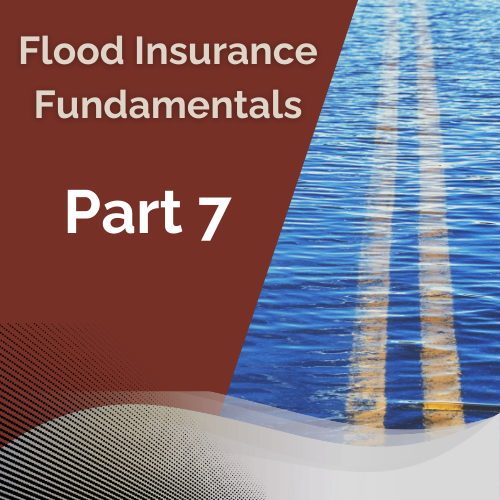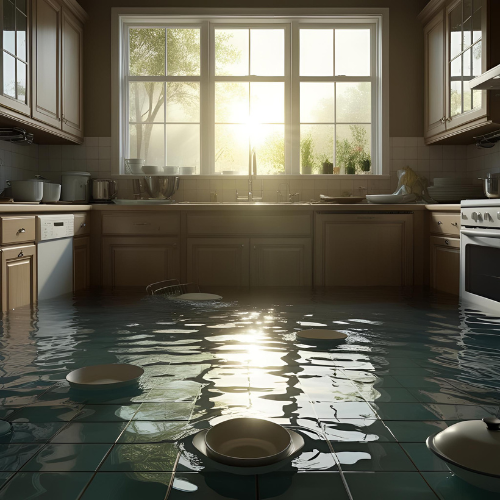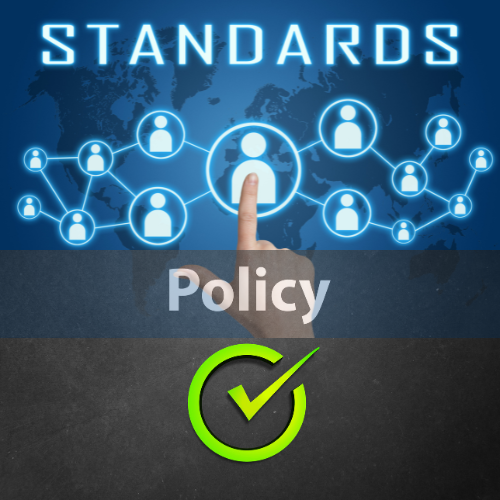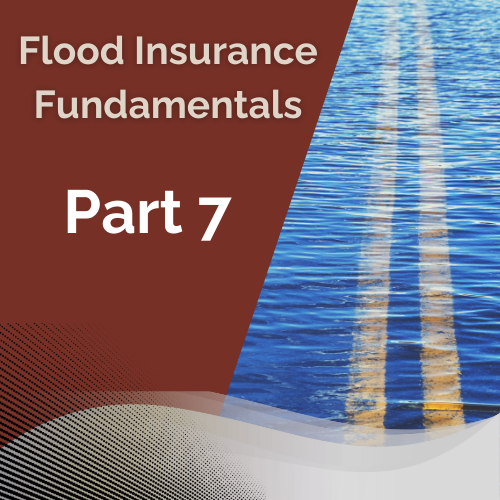Flood Insurance Fundamentals: Part 7

We’re on the Home Stretch!
Flood Insurance Fundamentals: Part 7 is designed to build on a strong foundation for understanding your NFIP Flood Insurance policy
- In this installment we will address:
- The coverages provided in the Standard Flood Insurance Policy (SFIP)
- Detail the Limitations and Exclusions within the SFIP; and
- Describe the Loss Provisions provided in the policy
We will illustrate the concepts by revisiting our case study that was introduced in Part 3. Let’s do that now!
Case Study

New Update!
- Our young couple purchased a two-story home with a basement and a detached garage in Miles City, MT, located in an AE flood zone
- The house, built in 1975, had already experienced damage from two previous floods in 1978 and 2011
- Six months after their purchase, in early April, ice jams formed at the confluence of the Tongue and Yellowstone Rivers, causing widespread flooding
- The floodwaters inundated the first floor of their new home with a foot of water
- The couple was devastated, now what?
Our couple, like most people, did their best to prepare, but when the unexpected happens, they wonder, ‘What happens now?
To navigate the next steps, they must understand their policy
The Standard Flood Insurance Policy (SFIP)

Only 3 Types!
- The NFIP’s Standard Flood Insurance Policy (SFIP) comes in three flavors:
- The Dwelling Form
- The General Property Form
- The Residential Condominium Form
The Dwelling Form
- The NFIP’s Dwelling Form provides building and or personal property coverage for specific building occupancy types:
- SingleFamily Home
- Single-Family Residential Unit within a:
- Residential or non-residential condominium building
- Non-Condominium residential or non-residential building, e.g., apartment building or residential cooperative building
- Townhouse or Rowhouse building
- Two-to-Four Family Building
- Residential Manufactured/Mobile Home
The General Property Form
- Just like the Dwelling Form, the NFIP’s General Property Form also provides building and or personal property coverage for specific building occupancy types:
- Non-Condominium Residential Buildings with five or more units
- Apartment buildings
- Co-operative buildings
- Dormitories
- Assisted living facilities
- Non-Residential Buildings
- Office buildings
- Schools and Churches
- Factories and Warehouses
- Agricultural buildings
- Restaurants
- Non-Condominium Residential Buildings with five or more units
The Residential Condominium Building Association Policy
The residential Condominium Building Association Policy Form is a little different from the other two
It provides building and, if purchased, contents coverage for commonly owned property
- There are some requirements to qualify for this form:
- It is issued to a residential condominium association
- The condominium buildings must have 75% or more of the total floor area dedicated to residential use
- It must be purchased on behalf of an association and unit owners
- It is the only NFIP policy form with a co-insurance clause
Now that we understand the three options for the Standard Flood Insurance Policy, let’s explore the coverage each one provides
The Four Coverages of SFIP

Four Walls of Protection!
The Standard Flood Insurance Policy is a single peril property policy meaning, it will pay for direct physical loss by or from flood and that’s it
- There are four coverages in the SFIP:
- Coverage A: Building Property
- Coverage B: Personal Property
- Coverage C: Other Coverages
- Coverage D: Increased Cost of Compliance
To begin, we must grasp the NFIP’s definition of a building
What Qualifies as a Building
- Before diving into coverages, let’s clarify what the NFIP considers a building:
- A structure that is walled and roofed
- It must be affixed to a permanent site
- It must be principally above ground level
Coverage A: Building Property Explained
- For a structure to qualify for Coverage A, it must have:
- Two or more outside rigid walls
- A fully secured roof
- Be affixed to a permanent site
- Resistance to flotation, collapse, or lateral movement
- At least 51% of Actual Cash Value (ACV) above ground level
While the coverage limits and specific details may vary depending on the form and occupancy type, Coverage A is a fundamental component of all SFIPs, providing protection for the building structure itself
Special Considerations for Different Building Types
The NFIP recognizes various building types, each with specific requirements for Coverage A eligibility. Let’s examine these in detail:
For Manufactured/Mobile Homes & Travel Trailers
- To be Eligible These Must Be:
- Affixed to a permanent foundation
- Not supported by wheels or axles
- Anchored in Special Flood Hazard Areas (SFHAs) to resist flotation, collapse, or lateral movement
For Buildings Under Construction
- NFIP allows for issuance of SFIP before building is walled and roofed and
- Offers coverage while work is in progress except when:
- Construction is halted for more than 90 days
- Lowest floor, including basement floor of a non-elevated building or lowest elevated floor of an elevated building, is below BFE
- The building deductible is doubled until walled and roofed
- Covers materials and supplies while contained in an enclosed building on premises or adjacent to the premises
- Offers coverage while work is in progress except when:
For Additions and Extensions
- The NFIP covers additions and extensions attached to and in contract with the building, by means of a:
- Rigid exterior wall
- Solid load-bearing interior wall
- Stairway
- Elevated walkway
- Roof
Note: At your option, additions and extensions connected by any of these methods may be separately insured
For a Detached Garage
- At the Policyholder’s Option and under the dwelling form only:
- 10% of the building coverage can be applied to a detached garage
- There is no additional coverage
- It reduces building limit of liability
Note: This option does not apply to any detached garage used or held for use for residential, business, or farming purposes
For Building Property
The NFIP defines building property as any building material or component that is fixed in place and part of the structure, enclosure, or building systems
Building property (Coverage A) is covered in all three Standard Flood Insurance Policy (SFIP) forms for all building occupancies
The following is not a complete list of covered Building Property:
| Awnings, canopies | Fire sprinkler systems | Permanently installed cupboards, bookcases, cabinets, paneling and wallpaper |
| Blinds | Walk-in freezers | Plumbing fixtures |
| Built-in dishwashers | Furnaces and radiators | Pumps and machinery for operating pumps |
| Built-in microwave ovens | Garbage disposal units | Ranges, cooking stoves and ovens |
| Carpet permanently installed over unfinished flooring | Hot water heaters, including solar water heaters | Wall mirrors, permanently installed |
| Central air conditioners | Light fixtures | Refrigerators |
| Elevator equipment | Outdoor antennas and aerials fastened to buildings |
Coverage B: Personal Property (Contents Coverage)
All three SFIP offer Coverage B – Personal property coverage
Remember, Coverage A and Coverage B are purchased separately and have separate deductibles regardless of the SFIP Form
- There are some nuances between SFIP Forms:
- Dwelling Form: If personal property is purchased, the SFIP insures:
- Personal property inside a building
- At the described location (inside a building)
- General Property/RCBAP: If personal property coverage is purchased, the SFIP insures:
- Personal property inside a building
- The building must be a fully enclosed insured Building
- Dwelling Form: If personal property is purchased, the SFIP insures:
The Case Study Review
Our young couple qualified for and purchased a NFIP flood insurance policy using a Dwelling Form
They purchased the maximum limits of both the Building coverage (Coverage A – $250,000) and Personal Property Coverage (Coverage B – $100,000)
The recent flooding damaged personal property in the detached garage
Under the SFIP Dwelling Form, the detached garage is a building at the described location
Personal property in the detached garage will be covered in the same manner as personal property that is located in the residence
Coverage B for the General Property Form
- This form allows for two possible ways for personal property to be covered:
- Household Personal Property: Represents typical household property of a residence
- Property belongs to the insured or to a member of the insured’s household
- Property belonging to a guest or domestic worker may be covered at the insured’s request
- Property belonging to others that the insured may be legally liable for if damaged or destroyed by flood
- Other than Household Personal Property: Represents personal property used in a business setting
- Furniture and fixtures
- Machinery and equipment
- Stock
- Other personal property owned by the insured and used in the insured’s business
- Household Personal Property: Represents typical household property of a residence
Note: Under the General Property Form, coverage will be either for household personal property or other than household personal property, while within the insured building, but not both
The Case Study: In the Basement
To continue the discussion from a flood loss and coverage standpoint, we will review flood damage to our young couple’s basement
Portions of the basement are finished with an office and a rec room area included
Significant damage occurred in the basement and our beleaguered young couple are wondering what is covered and what is not
Items Damaged in the Basement
| Desk and chair | All major mechanicals |
| Computer and printer | Appliances, including a refrigerator |
| Television and stereo | Electrical outlets |
| Pool table | Sump pump |
| Carpeting | Other personal items |
| Wall paneling |
To understand what is covered and what is not, we need to recall how the NFIP defines basements
Basements Are Defined As
Any area of the building, including any sunken room or sunken portion of a room, having its floor below ground level on all sides
Coverage A Applied to Basements
Coverage A (Building Coverage) for basements under the National Flood Insurance Program (NFIP) applies to specific items in basements, regardless of the flood zone
For post-FIRM enclosures in Special Flood Hazard Areas (SFHAs), similar coverage restrictions apply
In Basements Coverage A Applies To:
| Central air conditioners | Non-flammable insulation in a basement |
| Cisterns and the water in them | Pumps and tanks used in solar energy systems |
| Unfinished drywall (walls, ceilings) in a basement | Stairways and staircases (attached to building) |
| Electrical junction and circuit breaker boxes | Sump pumps |
| Electrical outlets and switches | Water softeners and chemicals in them, water filters and faucets installed as integral part of plumbing system |
| Elevators and related equipment | Well water tanks and pumps |
| Fuel tanks and fuel in them | Utility connections for items on this list |
| Furnaces and hot water heaters | Footings, foundations, posts, etc., required to support building |
| Heat pumps | Clean-up |
Coverage B Applied to Basements
Coverage B (Personal Property) for basements under the National Flood Insurance Program (NFIP) is very limited and applies to three specific items in basements, regardless of the flood zone
For post-FIRM enclosures in Special Flood Hazard Areas (SFHAs), similar coverage restrictions apply
- If a policy holder has purchased personal property coverage the following three items are covered in a basement:
- Portable or window air conditioning units
- Clothes washers and dryers
- Food freezers (other than walk-in) and food in any freezer
- Does not cover a refrigerator
Coverages C: Other Coverages
- Under Coverage C there are four Other Coverages:
- Debris Removal
- Loss Avoidance Measures
- Condo Loss Assessment
- Pollution Damage
Debris Removal
- The SFIP pays the expense to remove:
- Non-owned debris on or in insured property
- Debris of insured property anywhere
- Value of labor based on Federal minimum wage
Note: This coverage does not increase the Coverage A or Coverage B limit of liability meaning the additional coverages provided under Coverage C are included within the overall policy limits for Coverage A and Coverage B rather than being separate or additional amounts of insurance
Loss Avoidance Measures
- The SFIP pays the expense for:
- Sandbags, supplies and labor (up to $1,000)
- Property removed to safety (up to $1,000)
- Value of labor based on Federal minimum wage
Note: This coverage does not increase the Coverage A or Coverage B limit of liability and no deductible applies to either loss Avoidance measure
Condo Loss Assessments
- The SFIP pays the expense for:
- Condominium loss assessments (Dwelling Form):
- Assessed to policyholder by condo association
- Up to the Coverage A limit of liability
- Condominium loss assessments (Dwelling Form):
Note: This coverage does not increase the Coverage A or Coverage B limit of liability
Pollution Damage
- The SFIP pays the expense for:
- Pollution Damage (General Property Form)
- $10,000 maximum limit
- Does not include testing or monitoring unless required by law or ordinance
- Pollution Damage (General Property Form)
Note: This coverage does not increase the Coverage A or Coverage B limit of liability
Coverage D: Increased Cost of Compliance (ICC)
The final coverage in the SFIP is included to help policyholders cover the costs of bringing their flood-damaged properties into compliance with current floodplain management regulations
SFIP pays for complying with state or local floodplain management law or ordinance
- ICC coverage helps fund four types of compliance activities:
- Elevation: Raising the building to or above the flood elevation level adopted by local ordinance.
- Relocation: Moving the building out of the floodplain to a safer location.
- Demolition: Tearing down and removing the flood-damaged building.
- Floodproofing: Implementing certain measures to make the building resistant to flood damage (only available for non-residential structures)
- Eligibility requires:
- Substantial damage
- The building must be damaged by flood to the extent that repairs will cost 50% or more of the building’s pre-damage market value
- Some communities may have a lower threshold for substantial damage, which would also qualify
- Repetitive loss
- The building must have suffered flood damage on two occasions during a 10-year period
- The cost of repairing the flood damage, on average, must equal or exceed 25% of the building’s market value at the time of each flood
- Substantial damage
- ICC Limit of Liability is $30,000
- The ICC Limit of Liability of $30,000 does not add to the limits of liability for Coverage A
- The $30,000 ICC coverage is effectively a sublimit within the overall Coverage A limit
- ICC claims are filed separately from regular flood damage claims
Now that we’ve reviewed the coverages, let’s shift our attention to the exclusions
Exclusions

Not on the Menu
- The SFIP will not provide coverage for certain losses Losses that are not provided for include:
- Loss of revenue or profits
- Loss of access
- Loss of use
- Loss from interruption of business or production
- Additional living expenses
Examples of Property Not Covered (Partial list only)
| Personal property not inside a building | Land, land values, lawns, trees, shrubs, plants, growing crops or animals | Buildings and their contents if > 49% of ACV is below ground |
| Building, and contents in it, located entirely in, on or over water | Accounts, bills, coins, currency or other valuable papers | Fences, retaining walls, seawalls, piers, docks, etc. |
| Open structures, including a boathouse in, on, or over water | Underground structures and equipment, including wells, septic tanks, septic systems | Aircraft, watercraft or their furnishings and equipment |
| Recreational vehicles | Underground structures and equipment, including wells, septic tanks, septic systems | Hot tubs and spas that are not bathroom fixtures |
| Self-propelled vehicles or machines licensed for public road use | Containers and related equipment, such as tanks containing gases and liquid | Swimming pools and their equipment |
Important Exclusions to Know
- SFIP does not pay for losses for:
- Water or water borne material:
- Sewer and drain backups: This refers to water that flows backwards through plumbing systems into the insured property. It’s often caused by clogs or system overload, not necessarily by flooding
- Sump pump failures: When a sump pump can’t keep up with water inflow or malfunctions, leading to water accumulation in basements or crawl spaces
- Seepage or leaks: This covers gradual water intrusion through walls, foundations, or other parts of the structure. It’s often related to groundwater issues or poor waterproofing
- Damage from the pressure or weight of water
- This exclusion typically applies to damage to basement walls, foundations, or other underground structures caused by the pressure of water pushing against them
- It can also include damage from the weight of accumulated water on roofs or other parts of the structure
- This type of damage is often associated with saturated soil around a building or rising groundwater levels
- Water or water borne material:
Exception
Unless there is a flood in the area and the flood is the proximate cause of one of the excluded items:
- Proximate cause: This legal term means the primary or direct cause of damage. In this context, the flood must be the main reason for the otherwise excluded damage
- Flood in the area: There must be a general condition of flooding in the geographical area, not just isolated water issues on the insured property
- Overriding exclusions: If a flood directly causes sewer backup, sump pump overflow, seepage, or damage from water pressure, these typically excluded events may become covered
- Burden of proof: The policyholder may need to demonstrate that the flood was in fact the proximate cause of the damage
- Case-by-case basis: Each claim is evaluated individually to determine if the exception applies
More Gems For the Vault

Vital Information
Here’s the Things to Remember About this Discussion:
- The Standard Flood Insurance Policy has three policy forms:
- Dwelling Form
- General Property Form
- Residential Condominium Building Association Policy Form
- Each SFIP policy form consists of four major coverage areas:
- Coverage A – Building Property
- Coverage B – Personal Property
- Coverage C – Other Coverages
- Coverage D – Increased Cost of Compliance
- Building and Personal Property coverage is limited in basements and certain elevated building enclosures
Whew, That Was a Flood of Information!
Well played, NFIP—you’ve got the upper hand!
I thought I could wrap up the Loss Settlement Provisions in this part, but it looks like we need a sequel
Consider this a teaser for Part 8, where we take a deep dive into the weighty but important subject of Loss Settlement Provisions
See you soon!



Leave a Reply